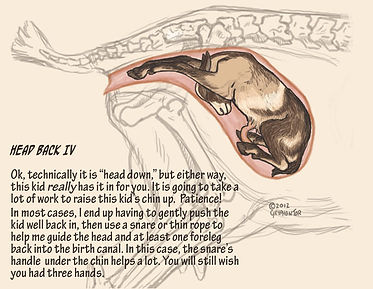Most Pygmy Goat breeders will now have their females in kid ready for spring kidding's, others will be thinking about putting theirs with a male of choice soon for summer kids and some breeders upon reading this article will also already have kids on the ground this is because pygmy goats aren’t seasonal like the larger Dairy Goats they can breed at any time of the year.
Pygmy Goats as we all know are much smaller in size than your typical dairy goat and therefore kidding can be a stressful time for us keepers. We have put together this guide to advise of the complications that can arise from kidding time and also to give advice on how to help solve the problems.
You must remember every herd is different and managed differently so what works for some leading up to kidding may not work for another. Some members scan and feed accordingly based on number of kids the doe is carrying while others just let nature take its course.
With Pygmy Goats you need to be calm and gentle at all times, kidding is a hard enough time for our girls without anything stressing them out even more , the vast majority of births go to plan and little intervention is needed, but it is good to know what to do in case of an emergency.
Because pygmy goats are small its essential to have small hands in order to intervene, if your hand is bigger than a kids head its unlikely you will succeed in ‘going in’ to help. If you do need to help compress your hand as much as possible and keep all your fingers close together to make things a little easier on the doe. Note she will scream and try and push against you if you do have to help this is normal.
If you can; have someone hold the doe in place who can keep her calm and talk to her if you have to work at her if you have no help may need to tie her to something to restrict her movement.. When going in you must ensure your hands are spotlessly clean and well lubricated, always move slowly and steadily and stay calm.
It can be difficult to know what you are feeling with your fingertips, I find closing my eyes and just using my sense of feeling really helps. A pointy little rump can be mistaken for a nose very easily.
· Your Vets Number or number of an experienced Pygmy Goat Breeder. This is the most important in any case when problems arise.
· Soapy Disinfectant—Betadine is a good option , this is the protect the doe, before attempting anything you must scrub your hands up to your elbows thoroughly and dry on a spotlessly clean towel or disposable paper towels. Scrub if you have to go in a second time or if your hands touch anything like bedding etc. Another option is to use long gloves but it can make things harder to feel.
· Water Soluble Lubricant , we use ‘lubigel’ - lots is always better than scrimping as its uncomfortable enough on your doe without friction also.
· Soft rope or lamb puller, to pull kids when necessary.
Responsible Goat Breeder should be willing to pay the cost to retain professional help from a vet should the situation prove to be beyond their ability, they should also know exactly when to make that important call.
Danger Signs—STOP and call the vet immediately if you notice any of the following;
· Kid is really stuck not moving at all and you have tried for more than 10 mins
· Bright Red blood , means internal bleeding and veterinary attention must be sought Immediately.
· A disgusting rotting smell , indicating a kid has died a few days previous.
· Signs the doe is in extreme distress
Know when to call, She is worth it , her kids are worth it and you are worth it don’t leave it too late as it can prove fatal to both mother and her kids.
Remember DO NOT PANIC!
To the right and below are images of complications and descriptions on how to correctly assist.
Kidding Guide
Featured in 2017 Annual Magazine
Essentials













